A furuncle (popularly also called a “boil”) is an acute purulent inflammation skin of the body, the causative agent of which is Staphylococcus aureus. Despite the fact that staphylococcus is dangerous disease, in most cases, people take inflammation extremely lightly. Many people make the mistake of not wanting to see a doctor about it. And this can lead to big health problems.
Is it necessary to open a boil?
Doctors note that if pus appears, then it is impossible to do without opening the boil. At this stage of the disease conservative methods The treatments with which therapy is usually started are already meaningless and do not help, which is why one has to resort to surgical intervention.
It must be remembered that the procedure for opening the boil does not cause complications and allows you to effectively get rid of inflammation; it lasts only a few seconds, but delay and constant “postponement” of the intervention is fraught with serious consequences.
If the inflammation is not touched, then there is a direct threat of infection spreading throughout the body - it can as soon as possible invade neighboring tissues (in the future, infection of the entire body and the formation of sepsis). As the infection grows, purulent foci can affect the lungs, liver, and brain.
In some cases, a boil can turn into an acute infectious inflammation, which (unlike, for example, an abscess) will no longer have boundaries - phlegmon. And if it is difficult to cure a local focus of infection, but still possible, then phlegmon will require inpatient observation.
Why can’t you treat a boil yourself?
Unfortunately, almost all people think that treating a boil is not particularly difficult. For them, this is not a dangerous infectious inflammation, but an ordinary pimple that can always be squeezed out. It is this misconception that most often leads to complications.
IN medical practice there is even a “classic” case of “home” treatment for a boil that became fatal for the patient - the death of a famous Russian composer who decided to pierce a boil on his face with a sterilized needle in the bathroom. Naturally, he did not die from the puncture itself, it was just that an infection from the skin got into the blood, which caused a serious complication.
If an abscess has appeared on the face or neck, then it must be treated exclusively in a specialized medical institution, since only a doctor (and no one else) can make a correct diagnosis and prepare treatment appropriate to the diagnosis.
When the abscess has not fully formed, there is a possibility that it will be possible to get by with conservative treatment, but after the formation of a purulent necrotic rod It is necessary to open and carefully clean the cavity of the boil by a doctor, and then maintenance therapy with antiseptic and anti-inflammatory ointments and tablets. Of course, an ordinary person who does not have sufficient medical knowledge and experience is unlikely to be able to cure himself.
How is the boil opened?
The procedure is carried out under local anesthesia, which completely removes pain. When performing an autopsy special attention is paid to the issues of hygiene and safety of the patient, since if an infection enters the blood, as mentioned above, infection and death are possible.
A boil is understood as a purulent-necrotic inflammation of the hair follicle. The disease is characterized by certain external symptoms. So, it appears in the form of a small plaque pink color with a pronounced point in the middle. Progression of the infection can be dangerous. And sometimes conservative and therapeutic methods Treatments do not always lead to successful results. In such cases, it is necessary to open the boil.
Opening a boil should be performed by doctors in a hospital setting
Mistakes when treating boils at home and what they do
The appearance of a boil is not considered by many to be a problem that can be called serious. A common pimple with large sizes does not pose a serious threat to health. But this doesn't always happen.
What causes the disease
The cause of the boil is Staphylococcus aureus. And the appearance of a boil is a direct factor in the infection of healthy tissues and hair follicles anaerobic type of bacteria. If a person finds such a tumor on his body, do not underestimate possible risk. After all, staphylococcus tends to quickly spread into healthy tissue. And its effect on the body, although not severe, is very painful. There is a risk that inflammatory processes will occur again and again. This relapse is called furunculosis.
Why boils cannot be opened at home
And if the boil does not open on its own, what should you do in this case? After all, the very nature of such a neoplasm is unusual. Pus accumulates in the hair follicle and it must break out on its own. Little depends on human actions. The only thing it can do is speed up the ripening process. Although some people are accustomed to solving this problem by opening the boil themselves, such actions are not always effective. By squeezing out pus, you can only achieve short-term results - relief and relief from inflammation.
There is a high probability that the opened boil will not even have time to heal before a new tumor will appear nearby. And this is due to the remains of the infection, which, if the boil is squeezed out independently, can remain in the layers of the epithelium.
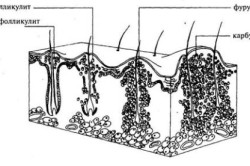
Normally, the boil bursts on its own
Suppressing the causes of boils is the first step to healthy and clear skin
The appearance of a boil is a process that is unpredictable for a person. New growths appear anywhere completely painlessly. And a person notices it only when the inflammation begins to progress. Any therapeutic treatment, and even surgical intervention, requires identifying the main factors that provoked the spread of infection. These may be:
- neglect of hygiene;
- decreased immunity due to colds or infectious viral diseases;
- mechanical damage to the skin;
- profuse sweating;
- hormonal surges;
- chronic diseases.
Often the main reason for the appearance of boils on the body is stress. Especially if they are prolonged or accompanied by one of the other provoking factors. And no matter what type of treatment the patient undergoes, he needs to completely solve the provoking problems. Without this, the risk of recurrent symptoms will be great. Likewise, the question of how to open a boil must be approached only after the main provocateur has been identified and neutralized.

Maintaining personal hygiene is an excellent prevention of boils
The importance of proper opening of the boil
The need for an autopsy depends on the stage of development of the boil itself. So, in the initial stages of its appearance, no prompt action should be taken. They are simply meaningless. The amount of accumulated pus that is present in the cavity of a young boil cannot be squeezed out through a peak that has not yet formed. You can only speed up the process. Using special ointments and creams, or some folk remedies, you can prepare the boil for a mini-operation.
Rod formation stage
The formation of a purulent core is a slow, not very pleasant process. Inflammation of the epithelium, often accompanied painful sensations, itching and fever. All that remains is to understand when the right moment comes to move on to operational methods. A boil has some factors that indicate that it is ready to “break open.” These include:
- Appearance of the neoplasm. It becomes elongated towards the middle with a clearly visible hole in the middle.
- Hardness. If you touch the boil, you can feel its compaction, which is harder towards the middle of the neoplasm.
- White dots. This is the pus that has already accumulated at the exit to the surface.
Inaction during such a period can play a cruel joke. This neoplasm itself is opened, but the remnants of the infection will not be removed from the inner layers of the epithelium. And this is the main sign that staphylococcus can continue its influence on human skin.
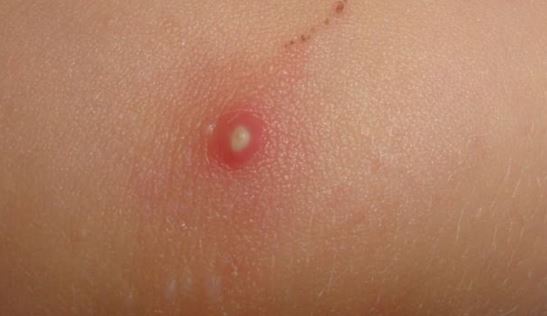
Forming a rod is a rather lengthy process
Squeeze out or operate?
Many people who have boils on their skin are in no hurry to see a doctor for help. After all, everything can be solved simply and quickly. Squeezing out boils is a natural process for many. And the desire to fix everything on your own takes precedence over common sense. After all, most of these people squeeze out tumors without realizing the reason for their appearance and the consequences that may arise. In fact, there is a big risk. And it is associated with such factors as:
- Infectious nature of the boil. Microorganisms that remain inaccessible will continue to spread in those places where there are hair follicles.
- Not sterile conditions when extruding. It is easy to get an infection, which will lead to new inflammatory processes.
- Poor or incorrect treatment of a squeezed out boil can hamper the healing cycle, that is, give time for the remaining anaerobic microorganisms to spread to healthy areas of the epithelium.
All actions that are carried out at home will not bring the result that is expected from this “squeezing”. And even the most simple treatment of inflamed skin often becomes a barrier that is difficult to overcome. After all, caring for a wound should not be a one-time thing.
The boil needs to be treated after opening antibacterial agent, anoint with healing ointment or cream and apply a bandage. And it is important that it is sterile.
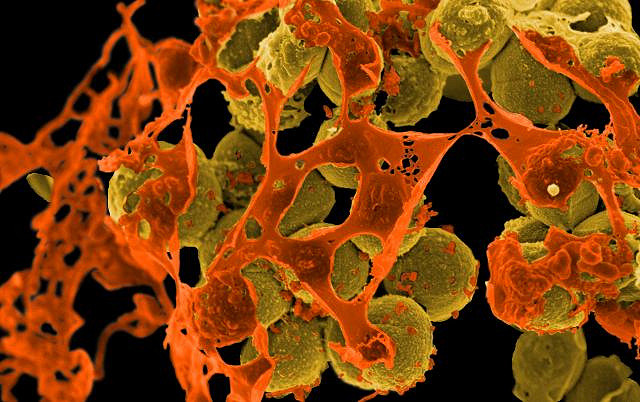
Microorganisms from a boil squeezed out at home will spread further throughout the skin
The healing process can be accelerated
Healing will occur more effectively only with daily dressing. And only then is there a high probability that the treated area will regenerate in healthy skin. But, it’s better not to take risks and entrust this, albeit not complicated, but important matter, to professionals. The doctor will not only carry out all the manipulations correctly and efficiently, but will also prescribe certain therapy that will help restore health faster. skin to its owner.
Surgery to remove a boil
Surgery to remove a boil is mild and minimally dangerous. The time it will take for such an intervention will not exceed 10 minutes. And most of it will go to the effect of the painkiller.
Many who decide to undergo such an operation often worry that everything will be normal. Such people have many questions, the answers to which are important for psychological state those undergoing surgery. They are especially concerned about the drainage of the boil. Indeed, during this operation, a device is installed into the wound, which is designed to remove pus. But don't worry. You won’t have to wear it for long if all the medications for healing the boil are selected correctly, as well as antibiotics that will suppress anaerobic microorganisms Staphylococcus aureus.
Stages of surgical opening of a boil
The operation process itself occurs in several stages:
- The inflamed area of skin is wiped with an antiseptic.
- On one or more sides of the boil, the doctor injects an anesthetic.
- Once the anesthetic has taken effect, the surgeon makes a small incision in the skin and removes the core of pus.
- After opening the boil, drainage is installed to remove the residues purulent discharge from its cavity.
- A bandage with a healing ointment is applied to the wound. It is secured with adhesive tape.
After the operation, the patient is sent home. There is no reason to keep him in the hospital. He only needs to appear for examinations and dressing changes. The risk of relapse is minimal. The main thing is to treat the wound daily and bandage it. And at the slightest fear that something has gone wrong, come for a consultation with your doctor.
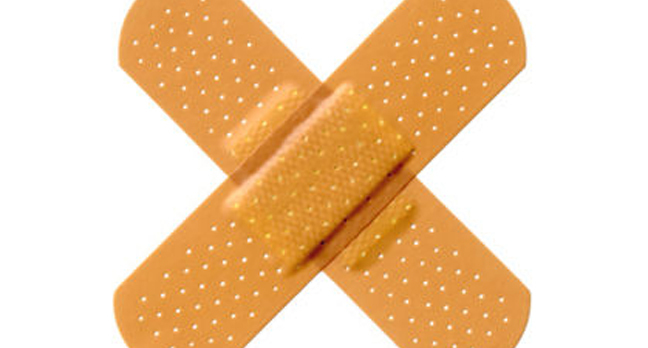
The breakout site is lubricated with ointment and sealed with a band-aid.
The healing process of an operated boil
The question of how long it takes for a boil to heal worries all people without exception who have squeezed out a tumor on their own or used the services of doctors. The answer to this question is difficult to obtain, because it depends on large quantity factors. Important role plays a role in cell regeneration. Each person has his own, special one. Additionally, attention should be paid to wound care. Whether the boil is opened independently or not is also important. After all, when home surgery the risk of relapse is high. And cones may form - suppuration. It is also possible that new growths may appear in other areas of the skin.
Not impossible and not enough effective action drugs for local application. So, even an ointment selected by a specialist may not demonstrate the quality of its intended purpose.
Usually, it doesn't take much time to restore skin health. Within a week, the first signs of recovery should appear. The wound should be wet. Dryness is the first sign of healing. The absence of any discomfort also occurs after a few days. But if such processes are not observed, then it is better to consult a doctor. Only he can determine the condition of the skin.
This disease is popularly known as a “boil,” and almost every person is familiar with its symptoms first-hand. An acute boil is called purulent process starting inside hair follicle. Over the course of several days, an abscess forms on the skin, which then opens and after healing can leave a scar in its place.
In many cases, it can be treated quite easily at home, but sometimes this practice is contraindicated.
When should you go to the surgeon?
Treatment of a boil must be carried out under the supervision of a doctor if:
- You are not sure that you have this particular disease.
To put it as simply as possible, a boil is big pimple, And appearance he has the appropriate one. If the lesion looks somehow different, it is likely that you have a different disease. - The boil is located on the face, especially in the nasolabial triangle.
Surely, as a child, you heard an instructive “horror story” about a student who, being late for a date, squeezed out an abscess under his nose and died a few days later from blood poisoning. It is difficult to say how real this particular story is, but it could very well turn out to be so. The face is an area of rich blood supply, so here an infection can easily penetrate into the blood (if a “pimple” is roughly opened, this is quite likely) and cause great harm. - The disease occurs in a serious form: the abscess is very large, accompanied by fever, you have several lesions on your skin, etc.
Previously, you already had boils that required the help of a doctor, but now the signs of the disease have appeared again. - You have diabetes.
Diabetics are a risk group for any purulent complications. Among such patients there are people in whom even a random callus on the foot can turn into an extensive phlegmon of the foot and lower leg. Due to metabolic disorders, the immune system suffers and healing processes slow down, which is why treatment can present certain difficulties. - A child developed a boil.
The increased likelihood of complications in children does not allow you to risk their health by practicing home treatment, especially if the parents do not have the appropriate experience. Be sure to visit a pediatrician or pediatric surgeon.
The first step of treatment. We are waiting for the boil to “ripen”
If you have not found any contraindications to home treatment, keep in mind that you need to start it at the first signs of illness.
Wash the painful area well with soap and apply a bandage with or: they have a resolving effect, that is, they accelerate the maturation of the abscess. Change dressings daily. In parallel with this, carry out thermal procedures, which also stimulate this process. Use a heating pad as a source of heat, placing it on the boil 2-3 times a day until it cools down.
Perhaps these measures will seem somewhat paradoxical to you, because, at first glance, such “treatment” will only worsen the situation. The area of redness will increase, and a white dot from the accumulation of pus. The sensations, of course, will also intensify... But this is necessary. While you are putting bandages on and warming up sore spot, Your body launches and develops defensive reaction, delimiting the infectious focus from healthy tissues. By the end of this period, all harmful bacteria will be neutralized and concentrated inside the purulent core, and the latter will then be brought out.
Such a process cannot be stopped, it can only be facilitated - and this is in your own interests. Medicinal herbal rinses, applying bread crumbs with salt at night and others traditional methods they won't help you here, so don't waste your time on them.
The maturation of the abscess lasts up to 5-7 days. At this time, it is necessary to spare the painful area and avoid squeezing or rubbing it. At this stage, the infection can still penetrate deeper into the tissue, and there is no need to help it with this.
How to determine that a boil can be opened?
The boil is “ready” for next step, If:
- the disease has lasted for about a week;
— a clearly visible white dot the size of a match head appeared on it, which slightly rises above its top;
- the skin around the lesion is red, hot, tense, sharply painful when touched;
— the boundaries of redness have become clearer than before.
Until you can tick off each of these points (the first two are especially important), you cannot move on to decisive measures. By squeezing out an “unready” abscess, you will only spread the infection around, and the next day you will eagerly go to the surgeon whom you were so afraid of before.
Second step. We open the boil.
Sometimes small boils open on their own, but in most cases they have to be “helped”: another 2-3 days may pass from final ripening to spontaneous opening, and it is at least unreasonable to endure the symptoms, knowing that you can get rid of them.
For this we need:
- small sharp scissors (both before and after the procedure they will need to be washed well under running water) hot water with soap and a brush, it is not necessary to sterilize - the purulent lesion itself is far from sterile);
- any available antiseptic (for example, hydrogen peroxide or salicylic alcohol);
- levomekol ointment;
- scissors for bandages;
- bandage or plaster;
- several gauze napkins (not cotton wool, it will “clog” the path for the outflow of pus!);
- container for used napkins.
For the procedure, choose a lighted place, place all objects on the table so that they are convenient to use. Wash your hands thoroughly and you are good to go.
First, the surface of the boil is treated with an antiseptic. After this, the purulent head is cut off (or pierced) with the tips of small scissors - it does not hurt, there are no nerve endings at the top of the abscess. The leaking pus is collected with napkins, its remains are carefully but completely squeezed out of the wound. When ichor comes out instead of pus, treat the lesion again with an antiseptic and apply a double gauze napkin with levomekol ointment on it, securing it with a bandage or plaster.
Third step. We help healing.
You may have to repeat the procedure for removing the pus in the next 2-3 days (it may accumulate again), but one thing is for sure: within a few hours you will feel much better, and the pain and tension will decrease.
In the future, repeat dressings with an antiseptic and levomekol daily. When only pinkish or light-colored liquid begins to come out of the wound, there will be no need for antibiotic ointment. At this time, 3-5 days after opening the abscess, the lesion will look like this: the elevation on the skin is almost imperceptible, the redness zone extends only directly around the healing wound, and it itself is no longer bright pink or red, but with a “stagnant” bluish tint and clear boundaries.
Until the weeping wound turns into a dry crust - this is another 4-5 days - you can again apply daily dressings with Vishnevsky ointment: it resolves stagnant processes and cleanses non-infected wound surfaces. Then, before the crusts fall off, the healing area is smeared with brilliant green, and after they come off, you can consider yourself completely healthy. The entire treatment process usually takes 10-14 days.
An uncomplicated boil is quite simple to treat, however, you must admit, this disease brings little joy. Therefore, when you recover, try to provide yourself with conditions in which the risk of its recurrence will be minimized. Carefully monitor your hygiene, be careful when shaving, choose loose clothing that does not press or rub anywhere - and you will never need the acquired skills in treating a boil again.
More useful materials:
- As you know, along with pediculosis (lice), scabies has always “thrived” in...
- You have psoriasis. How tired are you of these endless pills...
- Flux, or, as it is also called, jaw periostitis, is...
- Today, gastritis is a fairly common disease. Some associate...
- Arrhythmia is a fairly general concept that is used in medicine...
It is necessary to open the boil if, when using conservative treatment failed to stop the inflammatory process in early stage. Also, surgical intervention is carried out when there is a delay in rejection of the root of a purulent formation and the threat of an abscess.
A furuncle is a purulent-necrotic inflammation that affects the hair follicle and its surroundings. connective tissues. The causative agent of the disease is Staphylococcus aureus. The inflammatory process should not be taken lightly, especially if it is localized in the face or scalp. Incorrect application can lead to the spread of purulent contents through the lymph and bloodstream, provoke furunculosis (multiple abscesses throughout the body), and lead to sepsis.
Information about the disease
The process of boil formation:
- First appears on the skin painful lump red, resembling a subcutaneous nodule.
- Then this compaction increases, you can clearly palpate the boundaries of the infiltrate and see the appearance of edema.
- 3-4 days after the onset of the disease, the infiltrate softens, and purulent contents appear in a thick white or gray-yellow color.
- Subsequently, a greenish color appears, which is rejected along with purulent contents and a small amount of blood on days 6-7.
 After opening the boil, the ulcer heals within 2-3 days, but a scar may remain on the skin.
After opening the boil, the ulcer heals within 2-3 days, but a scar may remain on the skin.
Not correct treatment diseases can cause dangerous complications:
- lymphadenitis - enlarged lymph nodes;
- phlegmon - a common inflammation of fatty tissue;
- abscess - purulent inflammation of tissue with the formation of a purulent cavity.
Especially severe complications appear when they appear above the level of the mouth. The most dangerous of them: thrombophlebitis of the facial veins and the spread of infection into the cranial cavity, which can lead to meningitis and purulent encephalitis.
Treatment of the inflammatory process
If therapy starts at initial stage inflammation, then opening the boil may not be necessary.
- IN initial stage the abscess site is treated with means local action, accelerating the ripening process.
- Used as local therapy ichthyol ointment or Vishnevsky ointment. A bandage with these agents is applied directly to the site of inflammation. UHF, UV, and infrared radiation accelerates the maturation of an abscess.
- As soon as the purulent contents mature, the boil opens on its own.
- The cavity needs to be rinsed saline solution, apply syntomycin emulsion to the site of inflammation to prevent the penetration of a secondary infection.
 An effective treatment for furunculosis is the prescription of antibiotics. Oral use of antibacterial drugs can stop the inflammatory process.
An effective treatment for furunculosis is the prescription of antibiotics. Oral use of antibacterial drugs can stop the inflammatory process.
The development of a single purulent formation can be stopped with topical agents containing antibiotics. Such ointments destroy staphylococcus, stimulate intracellular metabolic processes in skin tissues, accelerate the regenerative process.
If local therapy is carried out antibacterial drugs, then it is better to choose ointments with additional anti-edematous and analgesic effects.
Opening the boil is necessary if additional symptoms appear:
- general increase in temperature;
- feverish condition;
- swelling and painful sensations in the area of inflammation.
The procedure is carried out in outpatient setting, under local anesthesia. The wound is treated with maximum precautions to prevent purulent contents from entering the bloodstream. After opening, the pus is removed, the cavity is cleaned, drainage is installed and a sterile bandage is applied. hypertonic solution or antibacterial ointment.
Prevention of furunculosis
 If a single boil appears, you should not try to open it yourself, especially at the stage of inflammation. Do not wet or steam the purulent neoplasm. All these actions contribute to the spread of infection throughout the body.
If a single boil appears, you should not try to open it yourself, especially at the stage of inflammation. Do not wet or steam the purulent neoplasm. All these actions contribute to the spread of infection throughout the body.
Is it worth opening a boil? A furuncle (the common name for the disease is “boil”) is a widespread purulent inflammation of the skin with localization of the process in the hair follicle and involvement of the sebaceous skin gland along with the surrounding tissue. By nature, a boil is bacterial infection, called in most cases Staphylococcus aureus, sometimes in association with other pathogens (streptococcus, gonococcus, E. coli, etc.).
The localization of the process can be very different in those places where hair grows on the skin. Boils on the face, nose, armpit, groin and neck are especially dangerous due to the proximity of large blood vessels and the possibility of spreading infection through blood.
Multiple factors contribute to the formation of an abscess:
- careless attitude to personal hygiene;
- reduced immunity;
- damage to the integrity of the skin in the form of scratches, abrasions, diaper rash, abrasions, etc.;
- obesity;
- excessive sweating;
- disease diabetes mellitus;
- hormonal disorders;
- significant temperature changes in the off-season;
- overheating and hypothermia;
- stress.
How to deal with a boil?
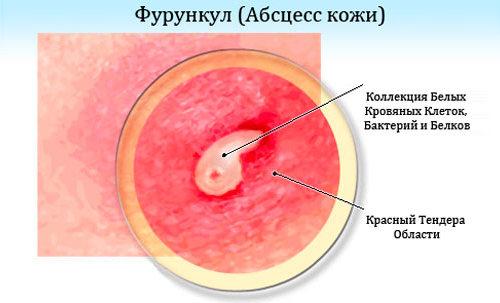 Furuncle or skin abscess The appearance of a boil cannot be ignored. If it is regarded as a banal pimple and is not accepted curative measures, then the time for conservative treatment will be irretrievably lost, and without surgical intervention can't get by. Any conservative therapy will no longer be effective.
Furuncle or skin abscess The appearance of a boil cannot be ignored. If it is regarded as a banal pimple and is not accepted curative measures, then the time for conservative treatment will be irretrievably lost, and without surgical intervention can't get by. Any conservative therapy will no longer be effective.
Only at the initial stage can one cope with inflammatory process, if you use an antibiotic and often smear this area of skin with alcohol (it is better to apply a cotton swab moistened with alcohol for several minutes). Effective method In addition to antibiotic therapy, conservative treatment is the use of Vishnevsky ointment, which has an anti-inflammatory effect.
At the site of the formation of the abscess, redness of the skin, thickening, and swelling are noted. These changes are accompanied by pain. Soon the pain takes on a throbbing character. If symptoms such as elevated temperature, weakness, headache, malaise, then the boil (its core) is already maturing and pus is accumulating.
Is it necessary to open a boil?
It has been used in surgery since the time of Hippocrates. golden rule: “where there is pus, excise and open.” True, after the necrotic rod or root (from dead tissue) has matured in the center of the abscess, the opening of the boil can occur independently. In this case, the pus comes out.
But under no circumstances should you open, pierce or squeeze out an abscess yourself at home. This is fraught, firstly, with additional infection by other microflora, and secondly, it will cause the spread of infection with its introduction into the blood and the development of sepsis.
It is important for the patient to understand that only opening the boil by a surgeon will not lead to complications. The operation to remove a boil lasts several minutes, but allows you to effectively remove the abscess without dangerous consequences.
In case of “postponing until later” a visit to the surgeon due to fear of surgical intervention and the use of traditional treatment there is a threat not only of the formation of a deep abscess (abscess) when the disease spreads to neighboring tissues, but also of the formation of abscesses even during internal organs.
How is a boil opened?
![]() The operation is performed under anesthesia. Surgical removal of the boil is performed on an outpatient basis. Patients are hospitalized only if complications of the disease develop (if the patient presents late) and if the abscess is dangerously localized on the face, neck or with a boil of the nose, or with severe swelling. A nasal boil is opened by an ENT doctor.
The operation is performed under anesthesia. Surgical removal of the boil is performed on an outpatient basis. Patients are hospitalized only if complications of the disease develop (if the patient presents late) and if the abscess is dangerously localized on the face, neck or with a boil of the nose, or with severe swelling. A nasal boil is opened by an ENT doctor.
Opening a boil is usually done using local anesthesia. For anesthesia, Novocaine, Ubestezin, Lidocaine, and Chlorethyl irrigation can be used. Therefore, opening the boil is not painful for the patient.
Purpose surgical treatment is to remove the core (root) of the boil and ensure the outflow of pus. The doctor opens the abscess and removes the rod using a scalpel and scissors. In some cases, after opening the boil, the surgeon leaves a drainage (rubber sterile strip) in the wound so that pus comes out of the wound. At home, it is impossible to properly open the abscess and select the correct treatment after surgery on your own.
After opening the boil, treat the wound with hydrogen peroxide and apply a sterile bandage. After the operation, the temperature returns to normal, the induration and swelling gradually subside. The reappearance of fever after surgery indicates retention of pus. The drainage is removed after the pus has completely drained.
At the stage of wound epithelization, ointments are used. Dressing is carried out daily. Antibiotic ointments may be prescribed. Good effect give bandages with ointment Levosin and Levomekol with healing and antibacterial effect.
Antibiotics (Sumamed, Amoxiclav, Ampicillin, etc.) are also prescribed orally or by injection. Usually a 5-day course is sufficient. Treatment is carried out until the compaction (infiltrate) completely disappears and the wound heals. It heals with the formation of a scar.
Innovative methods for removing boils
In many clinics, boil removal is carried out using modern high-tech methods - laser or radio wave method. And laser , and radio waves remove the abscess in a non-contact manner.
Application innovative technologies For complete cure from a boil has such significant advantages over surgical classical method:
- removal without pain (only tingling is felt);
- practically bloodless methods;
- the wound is disinfected with a laser, which prevents relapses;
- absence side effects;
- scars and cicatrices are not formed;
- quick release from an abscess: in 1 session lasting up to 30 minutes.
At the request of the patient, removal can be carried out using anesthesia; in this case, there are no any discomfort. Such operations are especially in demand for boils in children and when localized on the face and neck. Laser can also remove scars from previous boils.





